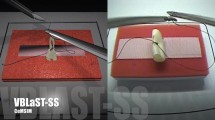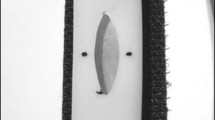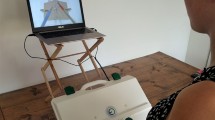Abstract
Background
Intracorporeal suturing is one of the most important and difficult procedures in laparoscopic surgery. Practicing on a FLS trainer box is effective but requires large number of consumables, and the scoring is somewhat subjective and not immediate. A virtualbasic laparoscopic skill trainer (VBLaST©) was developed to simulate the five tasks of the FLS Trainer Box. The purpose of this study is to evaluate the face and content validity of the VBLaST suturing simulator (VBLaST-SS©).
Methods
Twenty-five medical students and residents completed an evaluation of the simulator. The participants were asked to perform the standard intracorporeal suturing task on both VBLaST-SS© and the traditional FLS box trainer. The performance scores on each system were calculated based on time (s), deviations to the black dots (mm), and incision gap (mm). The participants were then asked to finish a 13-item questionnaire with ratings from 1 (not realistic/useful) to 5 (very realistic/useful) regarding the face validity of the simulator. A Wilcoxon signed rank test was performed to identify differences in performance on the VBLaST-SS© compared to that of the traditional FLS box trainer.
Results
Three questions from the face validity questionnaire were excluded due to lack of response. Ratings to 8 of the remaining 10 questions (80%) averaged above 3.0 out of 5. Average intracorporeal suturing completion time on the VBLaST-SS© was 421 (SD = 168 s) seconds compared to 406 (175 s) seconds on the box trainer (p = 0.620). There was a significant difference between systems for the incision gap (p = 0.048). Deviation in needle insertion from the black dot was smaller for the box trainer than the virtual simulator (1.68 vs. 7.12, p < 0.001).
Conclusion
Participants showed comparable performance on the VBLaST-SS© and traditional box trainer. Overall, the VBLaST-SS© system showed face validity and has the potential to support training for the suturing skills.


Similar content being viewed by others
Change history
05 December 2018
The surname of Sreekanth Arikatla incorrectly appeared as Sreekanth Artikala.
References
Maithel S, Sierra R, Korndorffer J, Neumann P, Dawson S, Callery M, Jones D, Scott D (2006) Construct and face validity of MIST-VR, Endotower, and CELTS: are we ready for skills assessment using simulators? Surg Endosc 20:104–112. https://doi.org/10.1007/s00464-005-0054-4
Chellali A, Zhang L, Sankaranarayanan G, Arikatla VS, Ahn W, Derevianko A, Schwaitzberg SD, Jones DB, DeMoya M, Cao CGL (2014) Validation of the VBLaST peg transfer task: a first step toward an alternate training standard. Surg Endosc 28:2856–2862. https://doi.org/10.1007/s00464-014-3538-2
Rodrigues SP, Horeman T, Blomjous MSH, Hiemstra E, van den Dobbelsteen JJ, Jansen FW (2016) Laparoscopic suturing learning curve in an open versus closed box trainer. Surg Endosc 30:315–322. https://doi.org/10.1007/s00464-015-4211-0
Sankaranarayanan G, Lin H, Arikatla VS, Mulcare M, Zhang L, Derevianko A, Lim R, Fobert D, Cao C, Schwaitzberg SD, Jones DB, De S (2010) Preliminary face and construct validation study of a virtual basic laparoscopic skill trainer. J Laparoendosc Adv Surg Tech 20:153–157. https://doi.org/10.1089/lap.2009.0030
Munz Y, Kumar BD, Moorthy K, Bann S, Darzi A, Munz Y, Kumar BD, Moorthy K (2004) Laparoscopic virtual reality and box trainers: is one superior to the other? Surg Endosc 18:485–494. https://doi.org/10.1007/s00464-003-9043-7
Fried GM, Feldman LS, Vassiliou MC, Fraser SA, Stanbridge D, Ghitulescu G, Andrew CG (2004) Proving the value of simulation in laparoscopic surgery. Ann Surg 240:518–525. https://doi.org/10.1097/01.SLA.0000136941.46529.56
Fried GM, Fried Steinberg-Bernstein GM (2008) FLS assessment of competency using simulated laparoscopic tasks description of the FLS manual skills component. J Gastrointest Surg 12:210–212. https://doi.org/10.1007/s11605-007-0355-0
Lim S, Ghosh S, Niklewski P, Roy S (2017) Laparoscopic suturing as a barrier to broader adoption of laparoscopic surgery. JSLS J Soc Laparoendosc Surg 21:1–7. https://doi.org/10.4293/JSLS.2017.00021
Zhang A, Hünerbein M, Dai Y, Schlag PM, Beller S (2008) Construct validity testing of a laparoscopic surgery simulator (Lap Mentor®): evaluation of surgical skill with a virtual laparoscopic training simulator. Surg Endosc 22:1440–1444. https://doi.org/10.1007/s00464-007-9625-x
Iwata N, Fujiwara M, Kodera Y, Tanaka C, Ohashi N, Nakayama G, Koike M, Nakao A (2011) Construct validity of the LapVR virtual-reality surgical simulator. Surg Endosc 25:423–428. https://doi.org/10.1007/s00464-010-1184-x
Larsen CR, Soerensen JL, Grantcharov TP, Dalsgaard T, Schouenborg L, Ottosen C, Schroeder TV, Ottesen BS (2009) Effect of virtual reality training on laparoscopic surgery: randomised controlled trial. Br Med J 338:b1802–b1802. https://doi.org/10.1136/bmj.b1802
Grantcharov TP, Kristiansen VB, Bendix J, Bardram L, Rosenberg J, Funch-Jensen P (2004) Randomized clinical trial of virtual reality simulation for laparoscopic skills training. Br J Surg 91:146–150. https://doi.org/10.1002/bjs.4407
Seymour NE, Gallagher AG, Roman SA, O’Brien MK, Bansal VK, Andersen DK, Satava RM (2002) Virtual reality training improves operating room performance: results of a randomized, double-blinded study. Ann Surg 236:458. https://doi.org/10.1097/01.SLA.0000028969.51489.B4
Hamilton EC, Scott DJ, Fleming JB, Rege RV, Laycock R, Bergen PC, Tesfay ST, Jones DB (2002) Comparison of video trainer and virtual reality training systems on acquisition of laparoscopic skills. Surg Endosc 16:406–411. https://doi.org/10.1007/s00464-001-8149-z
Diesen DL, Erhunmwunsee L, Bennett KM, Ben-David K, Yurcisin B, Ceppa EP, Omotosho PA, Perez A, Pryor A (2011) Effectiveness of laparoscopic computer simulator versus usage of box trainer for endoscopic surgery training of novices. J Surg Educ 68:282–289. https://doi.org/10.1016/j.jsurg.2011.02.007
McGaghie WC, Issenberg SB, Cohen ER, Barsuk JH, Wayne DB (2011) Does simulation-based medical education with deliberate practice yield better results than traditional clinical education? A meta-analytic comparative review of the evidence. Acad Med 86:706–711. https://doi.org/10.1097/ACM.0b013e318217e119
Gurusamy K, Aggarwal R, Palanivelu L, Davidson BR (2008) Systematic review of randomized controlled trials on the effectiveness of virtual reality training for laparoscopic surgery. Br J Surg 95:1088–1097. https://doi.org/10.1002/bjs.6344
Qi D, Panneerselvam K, Ahn W, Arikatla V, Enquobahrie A, De S (2017) Virtual interactive suturing for the fundamentals of laparoscopic surgery (FLS). J Biomed Inform 75:48–62. https://doi.org/10.1016/J.JBI.2017.09.010
Acknowledgements
This work was supported by the NIBIB/NIH Grant #5R44EB019802.
Author information
Authors and Affiliations
Corresponding author
Ethics declarations
Disclosures
Yaoyu Fu and Drs. Lora Cavuoto, Di Qi, Karthikeyan Panneerselvam, Gene Yang, Venkata Sreekanth Artikala, Andinet Enquobahrie, Suvranu De have no conflicts of interest or financial ties to disclose. Dr Schwaitzberg has no relevant conflicts related to this manuscript and is a consultant for Activ Surgical, Human Extensions, Arch Therapeutics, Acuitiy Bio, and Nu View Surgical.
Rights and permissions
About this article
Cite this article
Fu, Y., Cavuoto, L., Qi, D. et al. Validation of a virtual intracorporeal suturing simulator. Surg Endosc 33, 2468–2472 (2019). https://doi.org/10.1007/s00464-018-6531-3
Received:
Accepted:
Published:
Issue Date:
DOI: https://doi.org/10.1007/s00464-018-6531-3




